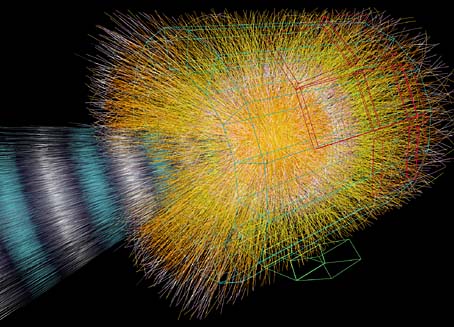Holding the World Together: Gluons and the Stability of Matter
Press Release No. 1/2009
21 07 2009
21 07 2009
Physicists investigate the behaviour of gluons in a short-lived state of matter
Physicists at Heidelberg University have been investigating the behaviour of gluons, the carrier particles of the strong interaction that hold quarks together and thus ensure the stability of matter at a subatomic level. They have succeeded in giving a more precise description of the properties of a short-lived state of matter occurring for very brief intervals during the collision of heavy ions at very high energies and collision of the particles. Their findings have been published in the journal Physical Review Letters journal. The theoretical calculations allow for predictions of expected experimental results at the LHC particle accelerator in Geneva (Switzerland).
The nuclei of atoms are made up of protons and neutrons. These so-called baryons consist of three quarks apiece. Between the quarks there is a strong interaction, one of the four fundamental forces in nature. This interaction is mediated by so-called gluons. As subatomic “adhesive” particles they are responsible for the attraction between the quarks and hence indirectly for the cohesion of neutrons and protons in atomic nuclei. This means that ultimately they ensure the stability of matter. Thirty years ago scientists at the DESY research centre in Hamburg were able to prove the existence of gluons (named after “glue”).
We now know that under certain circumstances—including very high energies of the colliding particles—the gluon density increases strongly. This effect is based on the self-interaction of the gluons. But gluons not only proliferate, at high density they also reunite. Accordingly, physicists proceed on the theoretical assumption that in this case short-term saturation will occur. For an interval of 10-23 seconds (for comparison, a nanosecond is 10-9 seconds) a new state of matter comes about, the so-called gluon condensate. Yacine Mehtar-Tani and Georg Wolschin of Heidelberg University’s Institute of Theoretical Physics have investigated indications for gluon saturation behaviour.
Their research is based on the work of numerous scientists who have been studying gluon behaviour in detail over the past few years. Central to the latest investigations are baryon distributions in heavy-ion reactions of gold and lead nuclei at “ultrarelativistic” energies. These investigations compare a new theoretical model proposed by the authors with experimental data from the European CERN research centre and the Brookhaven National Laboratory, USA.
The nuclei of atoms are made up of protons and neutrons. These so-called baryons consist of three quarks apiece. Between the quarks there is a strong interaction, one of the four fundamental forces in nature. This interaction is mediated by so-called gluons. As subatomic “adhesive” particles they are responsible for the attraction between the quarks and hence indirectly for the cohesion of neutrons and protons in atomic nuclei. This means that ultimately they ensure the stability of matter. Thirty years ago scientists at the DESY research centre in Hamburg were able to prove the existence of gluons (named after “glue”).
We now know that under certain circumstances—including very high energies of the colliding particles—the gluon density increases strongly. This effect is based on the self-interaction of the gluons. But gluons not only proliferate, at high density they also reunite. Accordingly, physicists proceed on the theoretical assumption that in this case short-term saturation will occur. For an interval of 10-23 seconds (for comparison, a nanosecond is 10-9 seconds) a new state of matter comes about, the so-called gluon condensate. Yacine Mehtar-Tani and Georg Wolschin of Heidelberg University’s Institute of Theoretical Physics have investigated indications for gluon saturation behaviour.
Their research is based on the work of numerous scientists who have been studying gluon behaviour in detail over the past few years. Central to the latest investigations are baryon distributions in heavy-ion reactions of gold and lead nuclei at “ultrarelativistic” energies. These investigations compare a new theoretical model proposed by the authors with experimental data from the European CERN research centre and the Brookhaven National Laboratory, USA.

| |
|
A computer simulation of a lead ion collision in the ALICE detector at the LHC of CERN in Genf. The first reactions will be investigated experimentally in 2010.
Ill: CERN
|
The energy generated by a heavy-ion collision produces thousands of highly interactive particles and their anti-particles. The difference between baryon and anti-baryon distributions is measured as a function of the scattering angle. Here events taking place at small angles (so-called forward angles) are of special significance. At certain scattering angles the net-baryon distribution attains maxima, the position of which depends on the formation of the gluon condensate. In principle, a precise measurement of this position can determine whether gluon saturation has occurred. The research done by the Heidelberg physicists has also enabled them to achieve a more precise determination of the properties of the gluon condensate.
So far, however, experiments with very high energies have been unable to create the conditions necessary for complete measurements of the maxima. “Our research results indicate that some conclusions about gluon saturation can also be drawn from the measuring data for baryons at wide angles of about 90°,” says Georg Wolschin. “But measuring the maxima at small angles would tell us much more.” In future investigations with the LHC, Wolschin adds, such measurements will only be possible after an extension of the present apparatus. The aim of this research is to obtain indirect confirmation of the gluon condensate and thus clarify a central issue in particle physics.
Original publication
Y. Mehtar-Tani, G. Wolschin: Baryon Stopping as a New Probe of Geometric Scaling, PRL 102, 182301 (2009), DOI: 10.1103/PhysRevLett.102.182301
Contact
Georg Wolschin
Institute of Theoretical Physics
phone: +49 6221 549415
wolschin@uni-hd.de
General inquiries from journalists should be addressed to
Heidelberg University
Communications and Marketing
Dr. Michael Schwarz
Public Information Officer
michael.schwarz@rektorat.uni-heidelberg.de
Irene Thewalt
presse@rektorat.uni-heidelberg.de
Editor:
Email

